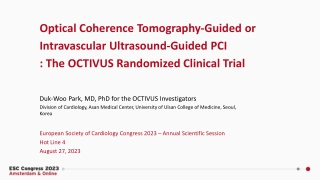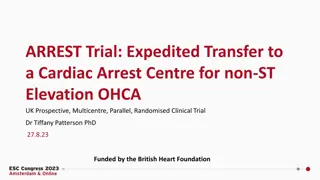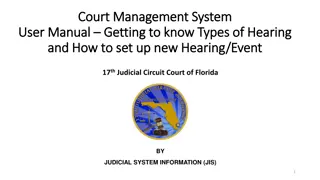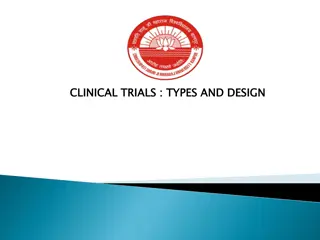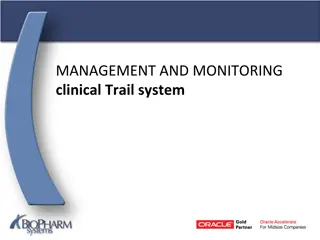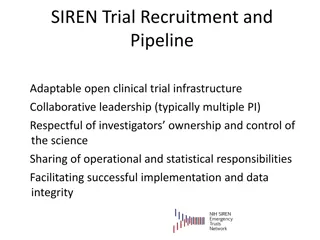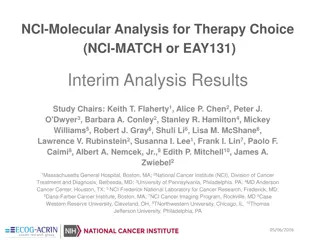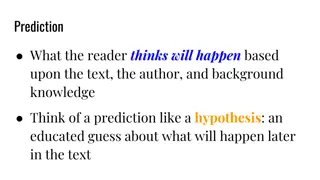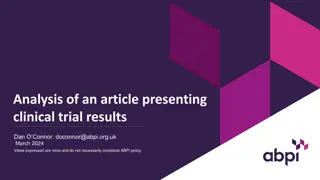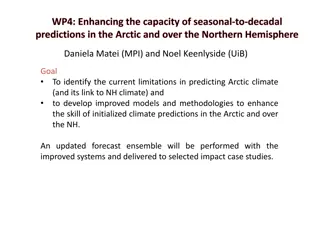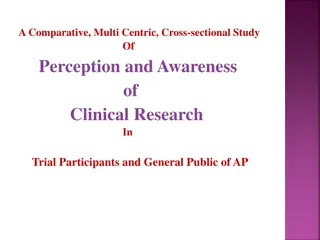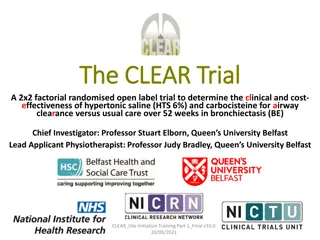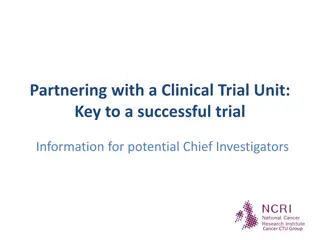Enhancing Clinical Trial Milestone Predictions with nQuery Predict
Explore the innovative tool nQuery Predict for accurate clinical trial milestone predictions, demonstrated in a webinar hosted by industry experts. Learn about key milestones, adaptive design considerations, enrollment predictions, and the significance of statistical approaches in optimizing trial designs. Discover how organizations leverage nQuery for successful FDA-approved trials and the potential of real trial data in ensuring trial schedules.
Download Presentation

Please find below an Image/Link to download the presentation.
The content on the website is provided AS IS for your information and personal use only. It may not be sold, licensed, or shared on other websites without obtaining consent from the author. Download presentation by click this link. If you encounter any issues during the download, it is possible that the publisher has removed the file from their server.
E N D
Presentation Transcript
INTRODUCING nQUERY PREDICT A New Tool for Clinical Trial Milestone Predictions DEMONSTRATED ON
Webinar Host Head of Statistics nQuery Lead Researcher FDA Guest Speaker HOSTED BY: Ronan Fitzpatrick Guest Lecturer
AGENDA 1. Clinical Trial Milestone Prediction 2. nQuery Predict Overview 3. Worked Example 4. Conclusions and Discussion
The complete solution for optimizing your clinical trial designs CRM MCP-Mod Simon s Two Stage Fleming s GST 1000+ Scenarios for Fixed Term, Adaptive & Bayesian Methods Survival, Means, Proportions & Count endpoints EARLY PHASE Group Sequential Trials Bayesian: - Assurance - Credible Intervals - Posterior Error Approach PRE-CLINICAL RESEARCH Animal Studies ANOVA / ANCOVA CONFIRMATORY Sample Size Re-Estimation Cross over & personalized medicine MAMS Cohort Study Case-control Study POST MARKETING
In 2020, 91% of organizations with clinical trials approved by the FDA used nQuery
Clinical Trial Milestone Prediction Part 1
Trial Design and Key Milestones Clinical trial design typically focusses initially on aspects such as operational, statistical and sample size considerations Adaptive Design consideration, statistical modelling choices, power calculations Most trials will have key milestones that need to be achieved before key decisions can be made such as interim analyses or ending the study Examples: Sample Size/Enrollment Target, Events Target for Survival Trials ~80% of trials delayed, ~85% do not reach recruitment goal Increasing interest in using real trial data to evaluate if trial are on schedule and what changes may be needed if not High potential for using statistical approaches for this purposes (sims, ML etc)
Enrollment Prediction Enrollment Prediction focussed on recruitment (sample size) milestones Key milestone for majority of clinical trials Multiple levels and approaches to look at enrollment prediction Level: Global, Regional, Site-level Approaches: Equation, Statistical Model, Simulation, Bayesian Can use prediction for key trial decisions e.g. add or drop sites due to performance
Enrollment Prediction Method Examples 1 Parametric Model e.g. Fit Linear, Polynomial, Poisson 2 Parametric Piecewise Modelling e.g. Piecewise Poisson 3 Global Simulation e.g. exponential inter-arrival times 4 Explicit Per-Site Simulation e.g. fixed rate per site 5 Per-Site Simulation via Model e.g. Poisson-Gamma Bayesian 6 Machine Learning Based on current and/or simulations 7 Others Regional Effects, Optimization, Cost
Survival Event Predictions Survival (Time-to-Event) analysis focussed on inference about time to event using methods such as Cox Regression Common Endpoints: Overall Survival, Progression-Free Survival Key milestones (interim analysis, study end) in survival analysis usually related to achieving a target number of events (e.g. cancer progress) Deviations from pre-trial analysis (e.g. SSD) common and of high concern Event milestone prediction requires modelling the survival process but likely also the accrual (i.e. enrollment) process & competing processes Competing Processes: Dropout, censoring, cure process, competing risks
Event Prediction Method Examples 1 Parametric Modelling e.g. Exponential, Weibull, Log-Normal 2 Parametric Piecewise Modelling e.g. Markov process (Lakatos) 3 Simulation using Survival Model e.g. Exponential, Piecewise Exp., Weibull 4 Model Selection Algorithm Select Models and/or Changepoints 5 Machine Learning Algorithm Trained on Current &/or Simulations 6 Non-Proportional Hazards Cure Rate Model, Responder -based 7 Other Considerations External Data (Bayesian), Blinded EM
nQuery Predict Overview Part 2
nQuery Predict Overview nQuery Predict is new tool in nQuery that will focus on clinical trial milestone prediction with a guided user-friendly interface Initial focus is on enrollment and event prediction via simulations Provide flexible options depending on information available and useful visualizations and reports to summarize simulation results Provides different options depending on access and granularity of data Provides useful complement to existing sample size determination tools in nQuery, especially for Phase III adaptive designs For example, interim analyses in context of group sequential design
nQuery Predict Features Two approaches: interim data and summary data Interim Data: Real Clinical Trial Data Arrival Times, Events Times, Current Status etc. Summary Data: Basic summary data (pre or during trial) Sample Size, # Events, Time etc. Targets: Enrollment and Event Milestones Poisson process for enrollment Blinded or Unblinded Event Process Exponential, Piecewise Exponential, Weibull Detailed Reports for Simulation Results Plots for Enrollment, Events, Dropout Trends Summary Report for Inputs & Results Optional Access to per-simulation results
nQuery Predict (1.0) Interim Data Summary Data Subject Level Modelling (Enrollment) Subject Level Modelling (Survival) Site Level Modelling (Enrollment) X Unblinded (Comparative) Survival Model Blinded (Non-Comparative) Survival Model Survival Model with Enrollment Ongoing Survival Model with Enrollment Complete Poisson Enrollment Model Exponential Survival Model Piecewise Exponential Survival Model X Weibull Survival Model X Exponential Dropout Model Piecewise Exponential Dropout Model X Weibull Dropout Model X X Fixed Followup X Pre-Trial Prediction X
Worked Example Part 3
Trial Summary Interim analysis conducted at 50% of total required events (187/374). Enrollment is 87% complete (402/460) with 118 out of 127 sites opened. In this example, will explore the following scenarios: Parameter Value Current Calendar Time 24.92 Current Sample Size 402 Current Events 187 Current Dropouts 3 Target Sample Size 460 Target Events 374 Subject vs Site-Level Enrollment Unblinded vs Blinded Survival Model Different Survival Models Sites Open 118
Discussion and Conclusions Delays very common in clinical trials due to missed milestones Need methods to help deal with enrollment and/or survival uncertainty nQuery Predict is new tool for clinical trial milestone prediction Enrollment & event prediction using simulation based on interim data Prediction models for variety of different levels of data available Summary Data (Pre/During Trial), Interim Data (Subject, Site-level) Methods available for Enrollment & Event Milestone Predictions Enrollment: Poisson (Subject or Site Level); Event: Exponential, Piecewise, Weibull, Fixed Followup, Dropout Processes
Thank You Free Trial |Questions info@statsols.com Further information at Statsols.com
References (Background) Lamberti, MJ. State of Clinical Trials Industry. Thomson Centerwatch. Clinical Trials Arena. 2012. Clinical trial delays: America s patient recruitment dilemma https://www.clinicaltrialsarena.com/analysis/featureclinical-trial-patient-recruitment McDonald, A.M., Knight, R.C., Campbell, M.K., Entwistle, V.A., Grant, A.M., Cook, J.A., Elbourne, D.R., Francis, D., Garcia, J., Roberts, I. and Snowdon, C., 2006. What influences recruitment to randomised controlled trials? A review of trials funded by two UK funding agencies. Trials, 7(1), pp.1-8. Bower, P., Brueton, V., Gamble, C., Treweek, S., Smith, C.T., Young, B. and Williamson, P., 2014. Interventions to improve recruitment and retention in clinical trials: a survey and workshop to assess current practice and future priorities. Trials, 15(1), pp.1-9. Cognizant. 2015. Patient Recruitment Forecast in Clinical Trials. https://www.cognizant.com/whitepapers/patients-recruitment-forecast-in-clinical-trials-codex1382.pdf Gkioni, E., Rius, R., Dodd, S. and Gamble, C., 2019. A systematic review describes models for recruitment prediction at the design stage of a clinical trial. Journal of clinical epidemiology, 115, pp.141-149. Kearney, A., Harman, N. L., Rosala-Hallas, A., Beecher, C., Blazeby, J. M., Bower, P., Gamble, C. (2018). Development of an online resource for recruitment research in clinical trials to organise and map current literature. Clinical Trials, 15(6), 533 542. https://doi.org/10.1177/1740774518796156
References (Enrollment) Lee, Y.J., 1983. Interim recruitment goals in clinical trials. Journal of Chronic Diseases, 36(5), pp.379-389. Comfort, S., 2013. Improving clinical trial enrollment forecasts using SORM. Applied Clinical Trials, 22(5), p.32. Carter, R.E., Sonne, S.C. and Brady, K.T., 2005. Practical considerations for estimating clinical trial accrual periods: application to a multi-center effectiveness study. BMC medical research methodology, 5(1), pp.1-5. Carter, R.E., 2004. Application of stochastic processes to participant recruitment in clinical trials. Controlled clinical trials, 25(5), pp.429-436. Senn, S., 1998. Some controversies in planning and analysing multi centre trials. Statistics in medicine, 17(15 16), pp.1753-1765. Anisimov, V.V. and Fedorov, V.V., 2007. Modelling, prediction and adaptive adjustment of recruitment in multicentre trials. Statistics in medicine, 26(27), pp.4958-4975. Anisimov, V., 2009, August. Predictive modelling of recruitment and drug supply in multicenter clinical trials. In Proc. of joint statistical meeting (pp. 1248-1259).
References (Enrollment) Anisimov, V.V., 2011. Statistical modeling of clinical trials (recruitment and randomization). Communications in Statistics-Theory and Methods, 40(19-20), pp.3684-3699. Bakhshi, A., Senn, S. and Phillips, A., 2013. Some issues in predicting patient recruitment in multi centre clinical trials. Statistics in medicine, 32(30), pp.5458-5468. Jiang, Y., Guarino, P., Ma, S., Simon, S., Mayo, M.S., Raghavan, R. and Gajewski, B.J., 2016. Bayesian accrual prediction for interim review of clinical studies: open source R package and smartphone application. Trials, 17(1), pp.1-8. Gajewski, B.J., Simon, S.D. and Carlson, S.E., 2008. Predicting accrual in clinical trials with Bayesian posterior predictive distributions. Statistics in medicine, 27(13), pp.2328-2340. Abbas, I., Rovira, J. and Casanovas, J., 2007. Clinical trial optimization: Monte Carlo simulation Markov model for planning clinical trials recruitment. Contemporary clinical trials, 28(3), pp.220-231. Moussa, M.A.A., 1984. Planning a clinical trial with allowance for cost and patient recruitment rate. Computer programs in biomedicine, 18(3), pp.173-179.
References (Events) Lakatos, E., 1988. Sample sizes based on the log-rank statistic in complex clinical trials. Biometrics, pp.229-241. Fang, L. and Su, Z., 2011. A hybrid approach to predicting events in clinical trials with time-to-event outcomes. Contemporary clinical trials, 32(5), pp.755-759. Rufibach, K. (2016). Event projection: quantify uncertainty and manage expectations of broader teams. 2016. http://bbs.ceb-institute.org/wp-content/uploads/2016/06/Kaspar-event_tracking.pdf. Walke, R., 2010. Example for a Piecewise Constant Hazard Data Simulation in R. Max Planck Institute for Demographic Research. Goodman, M.S., Li, Y. and Tiwari, R.C., 2011. Detecting multiple change points in piecewise constant hazard functions. Journal of applied statistics, 38(11), pp.2523-2532. Guyot, P., Ades, A.E., Beasley, M., Lueza, B., Pignon, J.P. and Welton, N.J., 2017. Extrapolation of survival curves from cancer trials using external information. Medical Decision Making, 37(4), pp.353-366. Royston, P., 2012. Tools to simulate realistic censored survival-time distributions. The Stata Journal, 12(4), pp.639-654. Crowther, M.J. and Lambert, P.C., 2012. Simulating complex survival data. The Stata Journal, 12(4), pp.674-687.


